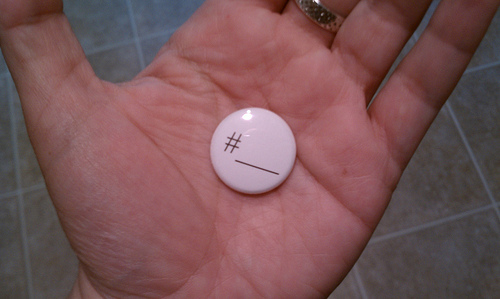
Note from Beth: You’ll find some good tips from David and Ehren on how to leverage their platform. I’d like to emphasize one of their points – “measure – experiment-measure.” Not every nonprofit is born with the “data driven gene.” One way your organization can begin to create a culture of measurement and learning is to always be piloting with small projects. Setting up a test of hashtag giving is an example. You’d test different calls to action on Twitter, using the Hashtag. Monitor the click thrus on bit.ly and use a tool like rowfeeder to capture the hashtag stream into a spreadsheet to analyze. You’ll can do some comparison testing of different calls to action and then refine what you’re doing. Just a small pilot, a little bit a data, and linked to decision-making can help your tweets have more impact.
Hashtags are like #snowflakes: A Guest Post by Ehren Foss and David J. Neff
HelpAttack.com is a way to give to nonprofits with each Tweet and Facebook update. We’ve recently added the ability to give each time certain #hashtags appear on Twitter, and Beth invited us to discuss what that might mean for networked nonprofits.
A hashtag is a term, usually preceded with a # symbol, that people use online, particularly with Twitter and other short messaging services. Each #hashtag is different. Many fit one of the following profiles, but you should always make sure you understand the community using each tag before you jump into the fray.
- Discrete Events: #sxsw, #ntc12, #bbcon, #df11: Many conferences, especially those with younger audiences or a focus on technology, use a hashtag to coordinate online conversation. #fundchat (a fundraising group on Twitter) and #ff are both regularly occurring online events. Also, when using Twitter, it’s difficult to avoid #maddow or #sytycd and other TV shows when they air.
- Ongoing Topics: Tags like #jobs, #education, #sales are informal (but useful) ways of asking questions, discussing, and commenting on certain topics. For example, SalesForce.com practitioners often #askforce.
- Trending Topics: At anytime on http://search.twitter.com , several of the most active topics on Twitter are also #hashtags. Today, #londonriots is clearly driven by events in the news, while #WhyAreYou and #ImTheTypeOfPerson are what we call “Fill in the blank” topics, where people answer a question,participate in a meme, or give their 2 cents.
- Intentional / Campaign Tags: #livestrong, #movember, #spoonie, and other tags are long running #hashtags that are suggested by, or organized around, certain groups or causes. Over time, branding is established and people begin to tie a certain tag to a particular cause or nonprofit.
- Tone: #ftw, #fml, #FAIL and others are used to add tone, feeling, and conversational shorthand to Tweets and other messages.
Are they reliable?
A hashtag with 10 million Tweets today might be almost a ghost town tomorrow. Also, because #hashtags aren’t as tied to the infrastructure of the web as a URL, they are subject to misspellings, mutation, and organic change. You may want to track a particular tag for a few days or weeks to see if it is being used consistently enough for your nonprofit to invest effort. In HelpAttack!, we allow each donor to set a limit for their giving, in case the #tag they are using takes off unexpectedly. We also use the ambient activity around that tag to suggest an amount to give each time it appears.
How To Use #hashtags for Giving
It’s a simple, 5 minute process (and free) to add your organization to HelpAttack!, and you can then add a video, picture, or story to your cause’s page. After that, and after you know what #hashtag (or other campaign) is right for your organization, you can decide how and when to encourage people to use the tag, or give using that tag. Then, make a few sample pledges and send them out as examples for people to join. By the way, your supporters don’t actually need to use their Twitter account to give each time a #hashtag is mentioned on Twitter. They can use a username and password or their Facebook account too. Each cause, community, and campaign is different, so be sure to use established best practices for social media and fundraising in general (you may be familiar with them already!):
- Make sure it’s easy to get from one channel to another (blog to website to Twitter to Facebook to…)
- Have a clear, simple, single call to action. The more asks you make simultaneously, the less response you’ll get.
- Enjoy the conversation. Look for questions, feedback, gripes, and praise, and respond! Your many supporters are far more creative than you are. 😉
- Experiment, measure, experiment, measure…your first #hashtag campaign will not be perfect, or your second. Be sure you are collecting the right data to make the right decisions around how to improve.
Are you planning an event? Is a celebrity advocate ready to support you online? Is there already a #hashtag in use by your volunteers, supporters, and community? If your online community and online donation practices are already pretty solid, why not empower your #hashtags for good? We know many nonprofits have included #hashtags in their messaging already (sometimes by accident). If you’re willing to share your wisdom, suggest ideas (or things to avoid), please do so in the comments!
About the Authors
Ehren Foss, Co-Founder and CEO: has a decade of diverse technical experience with web programming, database administration, and many of the open source tools that help make the web an amazing place to work. David J. Neff, Co-Founder: has over 10 years driving innovation and change in the nonprofit sector Nationwide.
